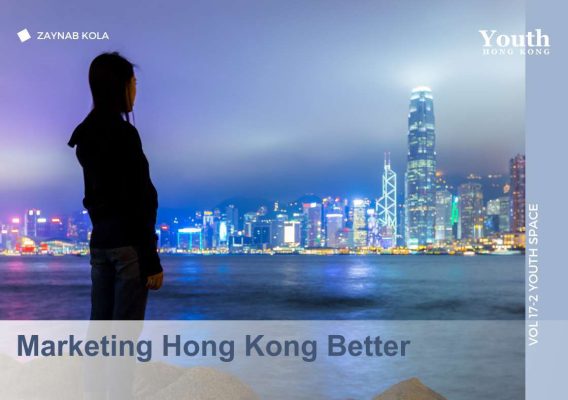by Zaynab Kola
Why is everyone flocking to Shenzhen? This youth-led rethink of tourism explains what we’re missing.
Hong Kong’s tourism campaigns, especially post-COVID, have fallen flat miserably, with the government failing to embrace our authentic identity, or keep up with the appetites of tourists. Instead, we see locals turning to Mainland China for excitement. I believe it has a lot to do with outdated strategies, which could be dealt with by youth flipping the tables for Hong Kong tourism with youth-driven solutions, like street culture, digital experiences, micro-influencer marketing, brand collaborations, and even a 90s Hong Kong revival.
As tourists and locals alike are wondering why everyone is flocking to Shenzhen, I decided to find out for myself. So, this past Easter holiday, I finally caved into the Shenzhen craze to see it for myself first-hand. Armed with curiosity and an Octopus card, I took the MTR to Lo Wu, I was whisked through the slick e-channel, and into Shenzhen. I had to find out why all of us—friends, colleagues, even my aunt—were suddenly dashing across the border.
What greeted us wasn’t the drab, factory-lined city of five years ago. It was fresh, it was vibrant, and it was full of character. The city pulsed to life in a manner Hong Kong has not in years. At the same time, Hong Kong’s tourism campaigns: “Hello Hong Kong,” “Night Vibes,” and the Temple Street “facelift” have flopped.
What is not anecdotal are figures. The numbers echoing in my news feed are thus: Shenzhen recorded over 100 million inbound and outbound travellers by May 2025, reaching this milestone 24 days earlier than in 2024. While at the same time, Hong Kong’s so-bright tourism received about 12 million mainland visitors from January to April, an 8% growth from the same period last year.
Why? Because Shenzhen discovered what Hong Kong remembered too late: authenticity can’t be faked, and culture can’t be bureaucratised. So, before we ask, “How do we reclaim our mojo?” Let’s take a deep dive into what is on offer in both cities.
Shenzhen vs Hong Kong
Yes, Shenzhen is cheaper. An afternoon of pampering at a high-end spa with arcades, buffets, and lounging space will cost you 300 Hong Kong dollars, cheaper than a Lan Kwai Fong cocktail. But if it were solely that, Macau would be empty. Shenzhen’s real charm lies in its cultural liquidity.
Hong Kong’s officials appear to be stuck in a tradition of top-down “revitalisation” programmes that have a tendency to overwrite the character they’re trying to cultivate. Shenzhen has it down to an art to develop culture in an organic way.
Shenzhen also knows how to build community, not crowds. The Spartan Race 2025, for example, is not just a sporting activity; it’s a seven-day pop-up festival of markets, live music, and local food stalls.
Hong Kong’s “Night Vibes” campaign, on the other hand, splurged on light shows and pressured “night markets” with the same expensive vendors. It is now soulless and counter interactive.
Shenzhen is also a guru at making something old into something new. Take the OCT Loft Creative Culture Park, which epitomises the art of renewal in the inner city, from run-down factories to a flourishing arts district. The government leniently taxed creative tenants and allowed the precinct to grow haphazardly. Compare it with what subsequently befell the Jumbo Floating Restaurant. Sunk after the government chose not to subsidise the preservation of what was historically worth saving.
Shenzhen actively sponsors micro-granted projects for standalone markets and pop-up licenses so that a younger generation feels connected to the future of the city. While Hong Kong’s youth-inspired projects, including the “Sham Shui Po Market Revamp,” are instead rejected in favour of generic shopping arcades.
Hong Kong’s Quandary
The post-COVID years have witnessed Hong Kong’s cityscape utterly reshaped with signature neighbourhoods stripped of their heart for bleak, profit-oriented projects. Short-term economic gains at the cost of cultural heritage have become the choice of the Urban Renewal Authority (URA), along with private developers, over creating something unique and vibrant.
The Temple Street Night Market, a once vibrant mix of fortune tellers, Cantonese opera performers, and steaming street food, had already seen half its hawker stalls gone since the 2000s. The government’s 2023 “revitalisation” project only exacerbated things, replacing what was left of the veteran hawkers with sterile food stalls and flashy neon lights, turning the market into a sanitised tourist trap, which tourists did not flock to.
The problem with Hong Kong’s tourist planners is that they are still employing the same old top-down approach, which does not appeal to today’s tourists. Take the complimentary air tickets giveaway, for example. The government spent millions on 500,000 complimentary flight tickets to try to coax tourists back, but failed to address the source of the issue: what to do once in Hong Kong. There just wasn’t a whole lot more to offer besides shopping and “gramable” locations.
Even the Wan Chai Pedestrian Zone, once a bustling street food street, was emptied in the name of “urban renewal,” replaced by a cleaned-up walkway avoided by locals. Without the dai pai dongs and hole-in-the-wall eateries, the area remains a ghost town at night.
“Hong Kong isn’t boring; it’s just marketed wrong.”
The city has an unmatched blend of East-meets-West culture, street attitude, and artistic subcultures. Instead of sanitising our identity, we should turn it up.
Why not legalise street art areas and repurpose vacant spaces as “Urban Culture Parks” with lawful graffiti, pop-up skate ramps, and night markets run by local designers? Other cities, like Berlin and Taipei, are thriving cities because they adore urban culture. We need to ditch the A-list promotions and invest in micro-influencer collaborations to promote off-the-beaten-path destinations.
Everyone is Y2K-obsessed, yet Hong Kong cannot seem to remember its own golden age. Why not develop 24-hour districts, where pubs and clubs can remain open later than midnight without complications? Learn from Shenzhen’s thriving 24-hour bookshops and nightlife, and don’t let Hong Kong lag behind.
One of the things that Shenzhen succeeds at is believing in its youth and giving culture room to breathe. I believe that Hong Kong fails by over-planning and sterilising everything that makes us unique. We don’t require more manufactured “vibes.” We do not need to be afraid of our own energy.
The question we should all be asking isn’t “Why is everyone going to Shenzhen?” It is “How long will it take us to fully realise the uniqueness of our culture and market it appropriately?” ■
Zaynab Kola, 15, from HKFYG Lee Shau Kee College, is an active participant in public speaking, debating, and the Model United Nations. Driven by a passion for justice, she is committed to transforming ideas into impactful advocacy. Beyond these pursuits, she enjoys fashion and writing thought-provoking articles on controversial issues.
Hong Kong’s Recent Tourism Schemes:
Hello Hong Kong (2023) was launched as Hong Kong fully reopened its borders following the easing of COVID-19 restrictions. It included a major initiative to give away 500,000 free round-trip air tickets to attract international tourists back to the city. The campaign also featured over 250 festivals and events throughout the year, such as the Clockenflap music festival, Hong Kong Marathon, Rugby Sevens, and Art Basel.
Night Vibes Hong Kong (2023) focuses on revitalising Hong Kong’s nightlife and boosting domestic consumption and tourism appeal. It features a wide range of night-time events including performances, cultural activities, markets, and guided tours at harbour-front locations.
The Revitalisation of Temple Street Night Market (2022) includes introducing about 30 new street food stalls operated by local restaurants and nearby eateries, along with live performances to enhance the atmosphere at the historic and once-bustling tourist hotspot. The market had declined due to COVID-19 restrictions and changing tourism patterns.



